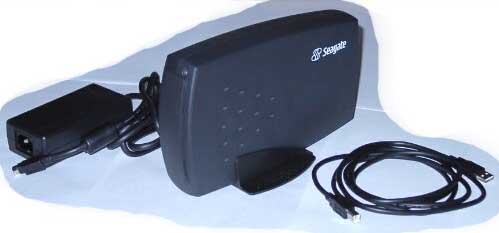 |
||
|
||
| ||
 This external hard disc with a USB interface, 40 GBytes, was produced by the well-known company SEAGATE. The market of external storage devices is intensively developing over the last few years. And in the near future the range of such devices will increase even more. Earlier this market was occupied only by small companies which produced both finished solutions (external cases with hard discs) and just cases in which users could install any disc they liked. Now this sector is conquered by such huge companies as Seagate and WD. Let's look at the factors which caused such companies to enter this market segment and work up a possible forecast for the following years. The range of application of hard discs is rather wide and is determined by their interface. The cheapest and the most convenient are IDE hard discs. But the IDE interface is impossible to use as external. Here it is replaced with USB 1.1 and FireWire (1394A). USB is the cheapest solution since USB controllers are built in
in all
FireWire has a higher data rate and is a more intellectual interface.
But a FireWire controller is to be bought separately. Plus, the interface
cables cost
But despite their disadvantages, these two interfaces are frequently used for connection of external storage devices. The connection is implemented via special bridges IDE-USB and IDE-FireWire. But, for example, in case of hard discs, they don't ensure a complete implementation of all their functions. For example, the only variant of a hard disc when you can load an operating system from an external HDD is a SCSI disc. But such interface is too expensive to use. Nevertheless, today the USB and FireWire developers hold talks with the top BIOS manufacturers AWARD and AMI on a possibility to load an OS from the devices based on these interfaces. This also concerns such new interfaces as USB 2.0 and FireWire (1394B). Another problem of USB and FireWire interfaces is that they are not "native" for hard discs. Soon, however, we will get a Serial ATA interface which will combine PnP possibilities of FireWire and cheapness and simplicity of IDE. The Serial ATA has a 4-conductor cable up to 1 m long which is very cheap to produce and easy to connect. The speed it ensures reaches 1.5 Gbit/s (160 MBytes/s). Today, though, some manufacturers consider the Serial ATA as an interface for connection of devices inside the case. On the other hand, the Serial ATA is already positioned as a competitor of USB 2.0 in the sphere of external data storage devices. Now let's look at the today's hero. Seagate DiskStor Specification
Accessories
The stylish black unit can be installed both in horizontal and vertical positions. An external power supply unit, on the one hand, is inconvenient since it takes place in the case (if you take it with you for traveling). But on the other hand, it releases you from provisioning of additional cooling. Nevertheless, the case has a place for a fan on the rear panel. The installation under the Windows 98SE was flawless. You are only to connect the disc to USB, turn on power, and the system will ask you for a CD with drivers. After that it is ready to work. The device is not included into the partition of USB devices of the system register. You can see it as a usual hard disc. The computer displays a disc of the U5 ST340823A series.  The only problem occurred when I was installing the device under the W2K. After installation of the drivers the system tried to create a new disc what resulted in a blue screen. Such problem occurred on two different computers. On the one hand, Windows 2000 still has difficulties with connection of PnP devices, despite the SP2. On the other hand, it may be drivers which do not work correctly under the Windows 2000. After the rebooting the problem wasn't faced anymore. The tests were conducted with the Winbench99 utility. WinBench99DataTransfer rate ~620 KBytes/s. At such a low speed we decided to test only the first 5 GBytes. It should be noted that the average data exchange rate is 808-950 KBytes/s for USB data storage devices. I suppose that such a low speed is connected with the drivers. Access Time: 28ms CPU Utilization: 6.98% Except the low speed, all the parameters are standard for the devices of this class. CopyingAfter that we conducted two tests of data copying: copying of one big file (~520 MBytes) and of a great number of small ones (4000 files of 190 MBytes).
As you can see, the speed of copying is almost the same in both cases. Besides, the speed in real tasks is a bit lower than in the WinBench99. Due to the lack of active cooling, the device makes no noise. The case doesn't heat up much as well. Despite a low data rate, the device performs well in such operations as playback of MP3 and MP4 files. Sometimes, though, MP4 video is played jerkily, but it is almost unnoticeable. Furthermore, you can store your photos on this disc. But the device doesn't suit well for making backup copies. SummaryI think, the device has come too late. Today a version with a USB 2.0 or
a FireWire is a more attractive solution. The optimal solution would be
a device with a dual USB/FireWire interface. The range of application must
be much wider in this case. Nevertheless, the top manufacturers have appeared
on this sector not in vain, and it means that they are going to take seriously
the sphere of external data storage devices.
Write a comment below. No registration needed!
|
Platform · Video · Multimedia · Mobile · Other || About us & Privacy policy · Twitter · Facebook Copyright © Byrds Research & Publishing, Ltd., 1997–2011. All rights reserved. |